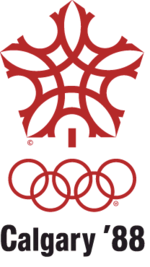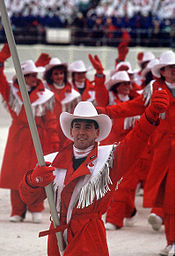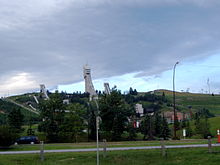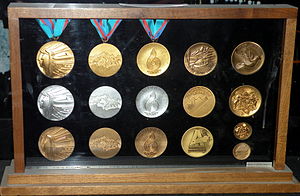- 1988 Winter Olympics
-
XV Olympic Winter Games 
The emblem is a stylized, pentagon-shaped, snowflake and maple leaf,made up of five large and five small letters of “C” to symbolize the country of Canada and the city of Calgary, above the Olympic rings.Host city Calgary, Alberta, Canada Motto Can You Feel It ? Nations participating 57 Athletes participating 1423 (1122 men, 301 women) Events 46 in 6 sports Opening ceremony 13 February Closing ceremony 28 February Officially opened by Governor-general Jeanne Sauvé of Canada Athlete's Oath Pierre Harvey Judge's Oath Suzanna Morrow-Francis Olympic Torch Robyn Perry Stadium McMahon Stadium The 1988 Winter Olympics, officially known as the XV Olympic Winter Games, were a winter multi-sport event celebrated in and around Calgary, Alberta, Canada from 13 to 28 February 1988. The host was selected in 1981 after having beat Falun, Sweden and Cortina d'Ampezzo, Italy. Most events took place in Calgary, although Alpine skiing took place in Kananaskis and Nordic skiing and biathlon taking place in Canmore. The games were held after the 1988 Winter Paralympics in Innsbruck, the last time the two tournaments were not held in the same city.
Fifty-seven nations and 1,423 athletes participated in the games, with five countries making their debut in the Winter Olympics. Super-G made its Olympic debut, while curling, freestyle skiing, short track speed skating and disabled skiing were demonstration sports. Speed skating was held in an indoor rink for the first time and the games were extended to 16 days.
Similar to the 1988 Summer Olympics, the Soviet Union and East Germany dominated the events, coming in first and second in the overall medal table. As at the 1976 Summer Olympics in Montreal, the only previous games hosted in Canada, the host country failed to produce any gold medals. Matti Nykänen won all three ski jumping events. Yvonne van Gennip won three gold medals in speed skating, setting two world records. Alberto Tomba won two gold medals in alpine skiing. Eddie "The Eagle" Edwards and the Jamaica national bobsled team entered with little experience but gathered massive media attention, resulting in qualification rules for later games.
Contents
Host city selection
Main article: Bids for the 1988 Winter OlympicsCalgary first tried to win a bid for the Winter Olympics in 1964, and again in 1968, but it was defeated by Innsbruck, Austria, and Grenoble, France, respectively.
Calgary finally won the bid for Canada's first Winter Olympics on 30 September 1981. It beat out Falun, Sweden and Cortina d'Ampezzo, Italy. (Cortina d'Ampezzo had previously hosted the 1956 Winter Olympics.) The vote was conducted by the International Olympic Committee in Baden-Baden, West Germany, at the 84th IOC Session and 11th Olympic Congress.
1988 Winter Olympics bidding results[1] City Country Round 1 Round 2 Calgary  Canada
Canada35 48 Falun  Sweden
Sweden25 31 Cortina d'Ampezzo  Italy
Italy18 — Background
All levels of Canadian government helped to fund the Games. The federal government, provided $225 million (note all figures listed in Canadian dollar, not adjusted for inflation), the province of Alberta paid $125 million and the city of Calgary with $50 million. The American host network, ABC, paid a then record $398 million, while the main host broadcaster, the CTV Television Network television network, paying $45 million for domestic rights. A further $90 million was raised by sponsorships and licenses.
Concern was raised almost from the beginning about the suitability of Calgary hosting the Winter Olympics because of the city's local weather conditions for the month of February. That area of Alberta is plagued unpredictably with a weather phenomenon called a chinook wind, which are periods where the weather becomes extremely unseasonably mild (above freezing) in short periods of time. A year prior to the event, the Whit Fraser report hinted that there was a possibility that mild winter weather could cause major problems for the Games. During the Games, there were indeed minor problems—for example, some bobsleigh runs had to be re-done because of sand getting blown onto the bobsleigh track.
This Olympic torch relay, with the theme "Share the Flame", stands as one of the longest in Olympic history, and especially for the Winter Olympic Games. It was a stark contrast to Canada's first Olympic torch relay for the 1976 Summer Olympics, which started in Ottawa and went directly east to Montreal; this distance, 200 kilometers (120 mi) is the shortest in Summer Olympic Games history so far.[citation needed] For Canada's first Winter Olympics, the Olympic torch, modeled after the Calgary Tower, was carried by both famous and ordinary Canadians in a continuous 88-day run across Canada, covering all 10 provinces and 2 territories (Yukon and the Northwest Territories; the territory of Nunavut did not exist until 1999), for a total distance of about 18,000 kilometers (11,000 mi). The torch traveled via ordinary running, dog sled, and snowmobile. Citizens won the chance to run a 1-kilometre (0.62 mi) distance with the Olympic torch by entering a lottery sponsored by Petro Canada.
The instrumental theme song ("Winter Games") and its vocal counterpart ("Can't You Feel It?") were both composed and performed by Canadian musician David Foster. Internationally recognized Canadian folk/country musicians Gordon Lightfoot and Ian Tyson were two of the featured performers at the opening ceremonies of the games, performing Tyson's "Four Strong Winds" and Lightfoot's "Alberta Bound" while a group of line dancers performed for the crowds.[2]
The official mascots of the games were two western-attired polar bears named Hidy and Howdy. The names were chosen from a field of 7,000 names through a contest sponsored by the Calgary Zoo. They were designed by Sheila Scott of Great Scott Productions, and produced by International Mascot Corporation of Edmonton, Alberta.
Highlights
 Brian Orser carrying the Canadian flag at the opening ceremony
Brian Orser carrying the Canadian flag at the opening ceremony
- The Games were opened by Governor General Jeanne Sauvé on behalf of Queen Elizabeth II at McMahon Stadium.
- Figure skating was showcased with the Battle of the Brians (United States' Brian Boitano and Canada's Brian Orser), the unexpected second place finish of Canada's Elizabeth Manley in Ladies' singles, and the Olympic debut of the Soviet Union pair couple of Ekaterina Gordeeva and Sergei Grinkov.
- Matti Nykänen from Finland dominated ski jumping events, winning three gold medals.
- Dutch speed skater Yvonne van Gennip won three gold medals, setting two world records.
- Alberto Tomba from Italy won two gold medals in alpine skiing.
- Two competitors, Eddie "The Eagle" Edwards of Great Britain in ski jumping and the Jamaica national bobsled team, entered their respective competitions with little experience and less chance of winning any medals. However, the determination of these novices to compete, in spite of being outmatched by their competitors, won the affection of the spectators and the media alike, which sometimes overshadowed the actual winners. They were hailed as demonstrating the true Olympic spirit as playing for the simple thrill of competition. The story of the bobsledding team was made into a 1993 Disney comedy film called Cool Runnings that was directed by Jon Turteltaub.
- The Super G alpine skiing event for both men and women made its Olympic debut.
- Curling, freestyle skiing, short track speed skating and Paralympic skiing were demonstration events.
- For the first time, the Winter Olympics were extended to 16 days, the long track speed skating events were held indoors on a covered rink, the alpine events took place on artificial snow, and warm Chinook winds not only threatened to cancel events, but sent a ski jumper flying into a camera tower.
- For the first time,since the 1960 Winter Olympics, the Closing Ceremony was held in the same main Olympic stadium as the Opening Ceremony at McMahon Stadium.
Legacy
Financial
Organizers and government claimed that the Calgary Olympic Games turned a profit. They declared a surplus of between $90 and $150 million, and this money was used to fund the various Olympic venues in Calgary. Ever mindful of the financial disaster of the 1976 Summer Olympics, Calgary organizers attempted to be financially successful, because there was political pressure on them to erase the spectre of a second Canadian Games at a loss. Organizers claimed that their use of these profits for the future Canada Olympic Park and the funding of Canadian athletes through the Calgary Olympic Development Association (CODA) gave Calgary a lasting legacy and impact on the Canadian sports scene, and also provided funds for the maintenance and upgrading of athletic facilities in Calgary, Banff, and Lake Louise. Well after the Olympics ended, they declared, CODA continued to use its resources to develop resources for Olympic athletes in the city, which included supporting the National Sport School, Canada's first high school designed for Olympic calibre athletes, in a partnership with the Calgary Board of Education.
However, a widely cited 1993 audit and independent research conducted by The Toronto Star in 1999 showed that these financial figures were largely false.[3] When announcing these numbers, organizers had removed from their calculations $461 million in subsidies provided by federal, provincial and local governments used mainly for building the games venues. When these government investments were included in the balance sheets, the Calgary Olympics were reported to have produced a sizeable financial loss. General infrastructure and venue costs do not go into the balanche sheets of an Olympic Organizing Committee. Only costs directly related to hosting the Games are included in the OOC's budget and balance sheets, as venues are often private or government built.
However, the games fuelled an endowment fund of $70.5 million that is now worth $185 million and continues to fund sport in a variety of ways. Additionally, the Calgary Olympic Committee (OCO) gave the Canadian Olympic Committee (COC) $40 million, which after investment is now worth $110 million; those funds assist the COC's $8 million annual contribution to national teams, coaches and athletes and permits its existence as a self-sustaining organization that does not rely on government funding.[4]
Infrastructure
Five world class facilities were built for the games, and several others were improved.
- Nakiska at Mt. Allan
- Olympic Saddledome
- Olympic Oval
- Canada Olympic Park
- Canmore Nordic Centre
Eight national teams use Calgary or Canmore as a home base, and Calgary has hosted 200 national and international competitions between 1987 and 2009 because of its Olympic facilities.[4]
Of 30 world records in speed skating, 17 of them have been set at the Olympic Oval in Calgary, considered the fastest ice in the world.[4]
Social
There was a substantial social impact as well. From the unprecedented volunteer involvement in staging the Games, a program was put in place where ordinary Calgarians could purchase, for $19.88 in the summer of 1986, a brick at the main medal presentation plaza called the Olympic Plaza with their names laser-engraved on it. The involvement of ordinary Calgarians was evident. This was of paramount importance to the organizing committee, OCO'88, as it kept the Games from appearing distant and "out of reach". Over 10,000 volunteers helped make the these games possible.
In 1999, a bribery scandal hit the Salt Lake Organizing Committee (SLOC) for the 2002 Winter Olympics. The main focus of that scandal was the tactics used by that organizing committee then to win the bid in Budapest, Hungary, at the 104th IOC Session in 1995. There was talk of stripping the rights of hosting the Games away at the time because of that circumstance. That whole scene played out before the unforeseen 9/11 terrorist attacks on New York City and Washington, D.C. on the United States. Calgary then sent an offer to step in to be an alternate host of the 2002 Winter Olympics, if Salt Lake City was unable to host the Games because of both counts.
Calgary tried again to bid for the Winter Olympic Games in 2010, but lost out when the Canadian Olympic Committee (COC) chose Vancouver as the city that would be the Canadian bid internationally. Eventually, Vancouver was chosen to host the 2010 Winter Olympics over PyeongChang, Korea, and Salzburg, Austria in July 2003 at the 115th IOC Session in Prague, Czech Republic.
As in the 1976 Summer Olympics, the host Canadian team failed to win a gold medal in the 1988 Winter Olympics. The Canadian Olympic Committee, determined not to see this happen a third time at the 2010 Winter Olympics in Vancouver, launched the Own the Podium program. Mogul skiier Alexandre Bilodeau finally won Canada's first gold medal on home soil at Vancouver and Canada finished off the Vancouver Games by winning 14 gold medals in all, a record for any nation at a single Winter Olympics.
Continuing funding of venues
The Alberta provincial government, under Ed Stelmach on 30 August 2007, committed CDN$69-million, of the Calgary Olympic Development Association (CODA) CDN$276-million overall project cost, to construct Canada's first Centre of Sport Excellence. This announcement included the unveiling of a new facility design for Canada Olympic Park (COP) called the Athletic and Ice Complex. Previous governments have already given funds recently to upgrade and/or maintain existing Olympic winter venues in Calgary and Canmore, Alberta in the past. For example, CDN$25.6-million was provided to renovate the Canmore Nordic Centre Provincial Park area, in time for the 2005 Alberta Centennial FIS World Cup event. CDN$600,000 was spent in maintaining the ski jumping venue at Canada Olympic Park.[5] On 5 October 2007, the Canadian federal government promised an additional CDN$40-million toward the project, according to an article written by the Canadian Broadcasting Corporation (CBC).[6]
Sports
See the medal winners, ordered by sport:
 Alpine skiing ()
Alpine skiing () Biathlon ()
Biathlon () Bobsleigh ()
Bobsleigh () Cross country skiing ()
Cross country skiing () Figure skating ()
Figure skating () Ice hockey ()
Ice hockey ()
 Luge ()
Luge () Nordic combined ()
Nordic combined () Ski jumping ()
Ski jumping () Speed skating ()
Speed skating ()
Demonstration sports
Exhibition sports
Venues
Main article: Venues of the 1988 Winter OlympicsWhen awarded the games, Calgary had very little in the way of sports infrastructure to host such an event. The following is a list of venues built for the games (see venues below for complete list of all facilities used for the games):
- Olympic Oval – for speed skating, which was the first time in Olympic history where the event took place indoors under climate controlled conditions. This, along with the high altitude of the city, resulted in a few world records in the sport being broken during the Games.
- Olympic Saddledome – Indoor arena for figure skating and ice hockey competitions (construction had already begun prior to the Games being awarded to Calgary). The Calgary Flames moved into the Saddledome for the 1983–84 NHL season.
- Canada Olympic Park – Bobsleigh, Luge, ski jumping, Nordic combined (ski jumping), freestyle skiing (aerials and ballet), disabled alpine skiing
- Canmore Nordic Centre Provincial Park – Cross-country skiing, biathlon, Nordic combined (cross-country skiing), blind cross-country skiing
- Max Bell Centre – Curling and short track speed skating
- McMahon Stadium – opening and closing ceremonies
- Nakiska – Alpine skiing, freestyle moguls skiing
- Stampede Corral – Figure skating and ice hockey (secondary venue)
- Father David Bauer Olympic Arena – Ice hockey (secondary venue)
Medal count
Further information: 1988 Winter Olympics medal tableA set of medals from the Games on display at the Scotiabank Saddledome in Calgary.
Rank Nation Gold Silver Bronze Total 1  Soviet Union (URS)
Soviet Union (URS)11 9 9 29 2  East Germany (GDR)
East Germany (GDR)9 10 6 25 3  Switzerland (SUI)
Switzerland (SUI)5 5 5 15 4  Finland (FIN)
Finland (FIN)4 1 2 7 5  Sweden (SWE)
Sweden (SWE)4 0 2 6 6  Austria (AUT)
Austria (AUT)3 5 2 10 7  Netherlands (NED)
Netherlands (NED)3 2 2 7 8  West Germany (FRG)
West Germany (FRG)2 4 2 8 9  United States (USA)
United States (USA)2 1 3 6 10  Italy (ITA)
Italy (ITA)2 1 2 5 13  Canada (CAN)
Canada (CAN)0 2 3 5 Participants
A record of 57 National Olympic Committees (NOCs) entered athletes at the 1988 Winter Olympic Games.
It was the first Winter Olympic Games for Fiji, Guam, Guatemala, Jamaica, and Netherlands Antilles.
 Andorra (4)
Andorra (4) Argentina (15)
Argentina (15) Australia (19)
Australia (19) Austria (81)
Austria (81) Belgium (1)
Belgium (1) Bolivia (6)
Bolivia (6) Bulgaria (26)
Bulgaria (26) Canada (112)
Canada (112) Chile (5)
Chile (5) China (13)
China (13) Costa Rica (2)
Costa Rica (2) Cyprus (3)
Cyprus (3) Czechoslovakia (59)
Czechoslovakia (59) Denmark (1)
Denmark (1) Fiji (1)
Fiji (1) Finland (53)
Finland (53) France (69)
France (69) East Germany (59)
East Germany (59) West Germany (90)
West Germany (90)
 Great Britain (48)
Great Britain (48) Greece (6)
Greece (6) Guam (1)
Guam (1) Guatemala (6)
Guatemala (6) Hungary (5)
Hungary (5) Iceland (3)
Iceland (3) India (3)
India (3) Italy (58)
Italy (58) Jamaica (4)
Jamaica (4) Japan (48)
Japan (48) North Korea (6)
North Korea (6) South Korea (22)
South Korea (22) Lebanon (4)
Lebanon (4) Liechtenstein (13)
Liechtenstein (13) Luxembourg (1)
Luxembourg (1) Mexico (11)
Mexico (11) Monaco (3)
Monaco (3) Mongolia (3)
Mongolia (3) Morocco (3)
Morocco (3)
 Netherlands (11)
Netherlands (11) Netherlands Antilles (2)
Netherlands Antilles (2) New Zealand (9)
New Zealand (9) Norway (63)
Norway (63) Philippines (1)
Philippines (1) Poland (33)
Poland (33) Portugal (5)
Portugal (5) Puerto Rico (9)
Puerto Rico (9) Romania (11)
Romania (11) San Marino (5)
San Marino (5) Soviet Union (101)
Soviet Union (101) Spain (12)
Spain (12) Sweden (67)
Sweden (67) Switzerland (67)
Switzerland (67) Chinese Taipei (13)
Chinese Taipei (13) Turkey (8)
Turkey (8) United States (117)
United States (117) Virgin Islands (6)
Virgin Islands (6) Yugoslavia (22)
Yugoslavia (22)
See also
- 1988 Winter Paralympics
- 1988 Summer Paralympics
- 1988 Summer Olympics
- Olympic games celebrated in Canada
- 1976 Summer Olympics – Montreal
- 1988 Winter Olympics – Calgary
- 2010 Winter Olympics – Vancouver
Notes
- ^ "Past Olympic host city election results". GamesBids. Archived from the original on 17 March 2011. http://www.webcitation.org/5xFvf0ufx. Retrieved 17 March 2011.
- ^ Gordon Lightfoot @ 1988 Calgary Winter Olympics on YouTube
- ^ Walkom, Thomas (8 February 1999). "The Olympic Myth of Calgary". The Toronto Star.
- ^ a b c "Legacies of North American Olympic Winter Games – Vancouver 2010". Archived from the original on 4 October 2009. http://www.vancouver2010.com/en/about-vanoc/organizing-committee/public-communications/reports/legacies-of-north-american-olympic/-/33488/qy26fo/index.html. Retrieved 2 October 2009.
- ^ [1] Archived November 9, 2007 at the Wayback Machine
- ^ "Feds chip in $40 million for Calgary sports paradise". CBC News. 5 October 2007. http://www.cbc.ca/sports/story/2007/10/05/olympic-park.html.
References
- "Calgary 1988". Olympic.org. International Olympic Committee. http://www.olympic.org/en/content/Olympic-Games/All-Past-Olympic-Games/Winter/Calgary-1988.
- "All the Medallists since 1896". Olympic.org. International Olympic Committee. http://www.olympic.org/en/content/All-Olympic-results-since-1896/?AthleteName=&Games=1334102&Country=&Sport=&TargetResults=true&resultsPageIPP=30.
- Olympic Review, March 1988 – Official results
Further reading
- Wallechinsky, David; Loucky, Jaime (2010). The complete book of the Winter Olympics (8th ed.). : Greystone Books. ISBN 978-1-55365-502-2. http://books.google.ca/books?id=6EThoEOnGuUC&lpg=PA152&dq=Canada%20at%20the%20olympics&pg=PP1#v=onepage&q&f=true.
External links
- "Calgary 1988". Olympic.org. International Olympic Committee. http://www.olympic.org/en/content/Olympic-Games/All-Past-Olympic-Games/Winter/Calgary-1988.
- The Calgary Olympic Development Association
- Canada Olympic Park
- CBC Digital Archives – The Winter of '88: Calgary's Olympic Games
- Possible 2010 Rendition of the Canadian Centre of Sport Excellence
- The program of the 1988 Calgary Winter Olympics
Preceded by
SarajevoWinter Olympics
Calgary
XV Olympic Winter Games (1988)Succeeded by
AlbertvilleOlympic Games Summer Games Winter Games 1 Discounted ex post facto by the IOC. 2 Cancelled due to World War I. 3 Cancelled due to World War II.Events at the 1988 Winter Olympics (Calgary) Alpine skiing • Biathlon • Bobsleigh • Cross‑country skiing • Curling (demonstration) • Disabled skiing (demonstration) • Figure skating • Freestyle skiing (demonstration) • Ice hockey • Luge • Nordic combined • Short track speed skating (demonstration) • Ski jumping • Speed skatingVenues of the 1988 Winter Olympics  Sport in Canada
Sport in CanadaMain articles Sport in Canada • Professional sport in Canada • Baseball in Canada • Canadian football
Cricket in Canada • Rugby league in Canada • Rugby union in Canada • Soccer in Canada • Volleyball in Canada • Canada GamesSignificant figures Canada at the.. Olympics • Summer Olympics • Winter Olympics • Paralympics • Commonwealth Games • Pan Am Games • Special OlympicsSummer Olympics stats Winter Olympics stats Paralympics stats (host nation) Commonwealth Games stats National sports teams A1GP • Australian football • Bandy • Badminton • Baseball • Basketball (men - women) • Cricket (men – women) • Field hockey (men – women) • Floorball (men - men's U-19 - women) • Football • Ice hockey (men – men's U-20 – women • women's U-18) • Ice sledge hockey • Inline hockey • Soccer (men – men's youth – women) • Softball (men - women) • Tennis (Davis Cup - Fed Cup) • Volleyball (men – women) • Water polo (men – women) • Rugby Rugby league • Rugby union (sevens)Ice hockey Football Baseball Teams... Active Baseball teams • Defunct baseball teamsOther sports Teams... Basketball • Lacrosse • Soccer
Tournaments... Golf • Motorsport • Tennis • Cycle • Soccer • Horse races • CurlingGoverning bodies Sport Canada • Secretary of State (Sport) • Karate Canada • Hockey Canada (Canadian Hockey League) • Equine Canada • Canadian Interuniversity Sport
Baseball Canada • Alpine Canada • Athletics Canada • Canadian Cycling Association • Canadian Lacrosse Association
Skate Canada (governing body) (Speed Skating Canada) • Canadian Soccer Association • Cricket Canada • Canada Rugby LeagueRelated Categories:- 1988 Winter Olympics
- Sport in Calgary
- 1988 in Canada
- Sports festivals in Canada
- Olympic Games in Canada
Wikimedia Foundation. 2010.


